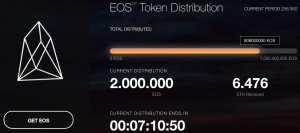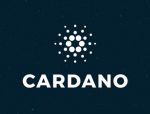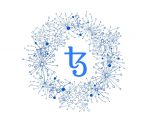One of the most interesting cryptocurrencies, EOS, will soon appear in the spotlight once its blockchain goes live in a few weeks, namely at the beginning of June this year. Many EOS fans believe that in the long run, EOS can overtake Ethereum as the world’s second-biggest technology after bitcoin. And if it turns out to be true, EOS can expect an increase in value.
| At eToro you can trade 49 currency pairs, including several cryptocurrencies. Join eToro |
EOS.IO is designed to eliminate some of the existing cryptocurrency challenges. According to Coinmarketcap, EOS is the 5th biggest cryptocurrency in the world, with a market value worth around 10 billion dollars. It is an interesting cryptocurrency, as many crypto-experts perceive EOS to be the biggest competitor of the crypto-giant Ethereum.
Moreover, during periods of sharp declines in the market, EOS has shown impressive stability, considering that most other cryptocurrencies experienced a significant fall in price. As such, EOS shows huge potential for the future.
What is EOS and why could it be a worthy investment?
EOS is the name of both a cryptocurrency and a blockchain technology. It can be compared to the technology and the cryptocurrency of Ethereum, as it allows external developers to build applications on the technology, so-called “smart contracts”. EOS, similarly to Ethereum, can be considered as a world’s computer. It’s basically a blockchain-based operating system designed to support decentralised applications by delivering a blockchain technology with all the necessary core functions needed for application building, including databases, accounts with permissions, planning, authentication and handling of communication between an application and the internet. EOS.IO software makes it possible for developers to focus on their own business ideas, instead of bothering themselves with coding functions that are already built in. In short, EOS can be understood as an operating system for “smart contracts” developers.
Furthermore, EOS can be seen as a fundamental solution to some of Blockchain’s problems, as it has incorporated the DPoS protocol (proof-of-stake protocol), which essentially works as a community responsible for transaction authentication. In comparison to the traditional blockchain system, EOS claims that their Blockchain DPoS protocol is capable of a higher transaction volume of about 100.000 transactions per second. Moreover, EOS will solve the question of transaction fees, which has often been an issue. In fact, the technology offers to eliminate transaction fees via an ownership model, where users own and have the right to use resources in proportion to their share of EOS, instead of paying for each transaction. Both high transaction costs and a limping transaction volume are Ethereum’s biggest weaknesses, which makes EOS a real contender for the crown.
EOS also introduced the ability to correct an error and make changes with the absolute majority consensus, rather than undergoing a “hard fork” – a situation, where a cryptocurrency becomes divided into two. This has happened with for example Bitcoin and Ethereum. A fork is used when the community behind a cryptocurrency disagrees on how a given coin or technology should develop. Here, EOS has the possibility to make changes and fix bugs, as long as there is an absolute majority. Thus, a “hard fork” is avoided. Although it makes EOS less decentralised, it allows ordinary businesses to adopt and interact with blockchain technology.
 In comparison to many of the first “coin offerings” that have happened over time, EOS has taken this initiative in a new and more interesting way. Many “coin offerings” have happened during a short timeframe, as a rule, a few hours. EOS went another way. Their “coin offering” has been active for a whole year – the first time, when such a process has been chosen. Every day, a certain amount of EOS coins is distributed. These coins are disseminated in proportion to the overall amount that is traded on the given day. Basically, if there are two competitors, one paying 8 eth and the other paying 2 eth, 80 and 20 per cent of the day’s coins will go to these two people respectively. The goal is to stabilise the price, and at the same time achieve recognition within the crypto world by continuously releasing news about EOS in line with their “coin offering”.
In comparison to many of the first “coin offerings” that have happened over time, EOS has taken this initiative in a new and more interesting way. Many “coin offerings” have happened during a short timeframe, as a rule, a few hours. EOS went another way. Their “coin offering” has been active for a whole year – the first time, when such a process has been chosen. Every day, a certain amount of EOS coins is distributed. These coins are disseminated in proportion to the overall amount that is traded on the given day. Basically, if there are two competitors, one paying 8 eth and the other paying 2 eth, 80 and 20 per cent of the day’s coins will go to these two people respectively. The goal is to stabilise the price, and at the same time achieve recognition within the crypto world by continuously releasing news about EOS in line with their “coin offering”.
Trading EOS – where and how
The process becomes more complicated if you wish to invest in EOS and at the same time have access to the digital EOS “coins”, for example, if you want to pay with it for products and services. You have to be prepared that you may have to trade on unregulated exchanges, that are NOT approved by financial regulators. This means that you may have problems with transferring your profits back to your bank account. It also means that you are more susceptible to a hack, which has become a part of the crypto world. If despite this, you wish to invest in this way, you can open a wallet with Coinbase, for example. You first transfer your money from your bank to the trading platform. The next step is opening a wallet with for example Binance, where you can trade EOS. Finally, you can transfer other cryptos, such as Litecoin, Bitcoin, or Ethereum from Coinbase to Binance, where you can then use them to speculate in EOS.
Who’s behind EOS?
EOS was established in 2017 by CEO Brendan Blumer and CTO Dan Larimer. The latter is also behind BitShares (a decentralised “asset exchange”) and Steemit (a blockchain-based social media platform). Dan Larimer is also credited with creating the concept of DPoS, as well as the concept of decentralised autonomous organisations (DAOs).
CEO Brendan Blumer is also the founder and CEO for ii5, which is a centralised property listing platform for real estate agents in India. Within ii5 Brendan Blumer also founded Okay.com (an ownership platform), that has merged with Asia Pacific Properties.
Another blockchain veteran involved in EOS is Brock Pierce, a CSO of Block.one. Brock Pierce is also the current chairman of the Bitcoin Foundation. In February this year, he has been named in Forbes magazine as one of the 20 richest men in the crypto world.
| At eToro you can trade 49 currency pairs, including several cryptocurrencies. Join eToro |
Conclusion
In short, EOS’ future looks good. It’s a strong competitor to Ethereum, as it offers advanced technology, as well as the ability to develop a decentralised operating system for building “smart contracts”. Moreover, EOS will eliminate transaction fees thanks to the introduction of the new ownership model. And last but not least, it introduces the ability to make changes and fix bugs with the absolute majority. As such, EOS solves many of the challenges currently faced by cryptocurrencies. In the long term then, there will be some good opportunities in EOS.







